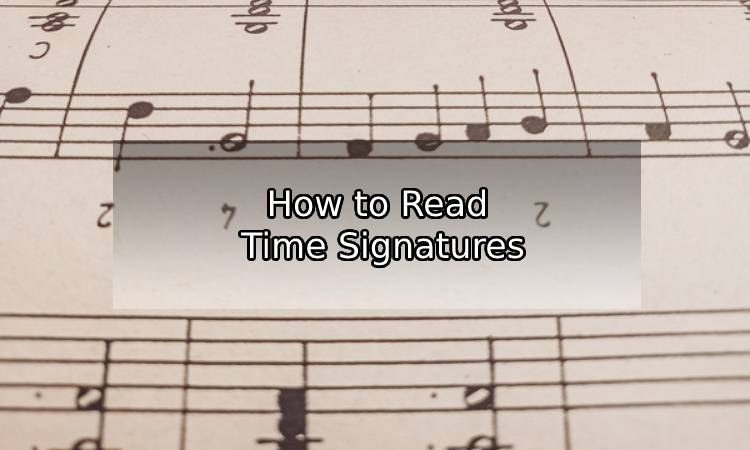The different note symbols show how the notes in a piece of music relate to one another in duration, but they don’t indicate the number of beats each note should receive. A piece’s time signature determines how many beats each type of note should get. The time signature of a piece is marked by a symbol that appears after the clef and key signature on the staff. It consists of a pair of stacked numbers:

- The top number: Indicates the number of beats that each measure should contain
- The bottom number: Indicates which type of note counts as one full beat
In the time signature symbol shown above, the “4” on top indicates that each measure has four beats, and the “4” on the bottom indicates that each quarter note counts as one beat. Each measure in a piece of music with this time signature must contain four beats’ worth of notes, such as four quarter notes, two half notes, or one whole note. There’s an infinite number of possible time signatures, but some, such as common time, are used much more than others.
Common Time

4/4 is the most popular time signature in Western music and, for that reason, is known as common time. Some pieces use the graphic symbol “C” (for “common”) in place of numbers to indicate that a piece should be played in common time. The table below shows how many beats whole, half, quarter, eighth, and sixteenth notes get in common time.
| Note Sign (Symbol) | Note Type | Number of Beats Note Gets | ||
| Whole note | 4 | |||
| Half note | 2 | |||
| Quarter note | 1 | |||
| Eighth note | 1/2 | |||
| Sixteenth note | 1/4 |
Cut Time
Though much less common than 4/4, the time signature 2/2 is the only other time signature that has a special name and symbol. It’s referred to as alla breve or cut time, and its symbol is the “C” symbol for common time with a vertical line through it.

Simple vs. Compound Time Signatures
All of the different time signatures used in music, including common time, fit into two main types: simple time signatures and compound time signatures.
- Simple time signatures: Have beats that can be subdivided into an even number of notes. In other words, each beat can be split in two and counted “one-and, two-and, three-and, four-and.” The most common simple time signatures give the beat to quarter notes—they are 4/4, 3/4, and 2/4. Simple time signatures are used in all types of music, from classical to rock to country to pop.
- Compound time signatures: Have bouncy beats that can be subdivided into an odd number of notes. The most common compound time signatures give the beat to eighth notes—3/8, 6/8, 9/8, and 12/8. They are counted like so: “one-ee-and, two-ee-and,” and so on. Compound time signatures are used primarily in jazz and classical music.
Empty Measures
If a composer wants to indicate that the musician should not play for an entire measure, the music will contain a whole rest. The whole rest tells the musician to play no notes for the entire bar. If a rest should last more than one measure, composers often use a multi-measure rest, which includes a number above it that specifies the number of measures the rest should last.

Incomplete Measures
Incomplete measures, also known as incomplete bars, are measures at the beginning or end of a piece of music, or of a section of music, that contain fewer beats than the time signature requires. For example, a song with a 4/4 time signature might begin with only one quarter note in the first bar (instead of four). Composers typically balance off incomplete bars by including one at the beginning and one at the end end of a piece or section. The two bars together add up to the proper number of beats that a regular measure should contain according to the time signature.

Changing Time Signatures Within a Piece of Music
A piece of music can change time signatures. When this happens, the new time signature is marked at the beginning of the bar at which the change occurs. The new time signature remains in effect until the end of the piece or until another time signature change is made.

